General George Owen Squier, of the U.S. Army Signal Corps, was an energetic evangelist for "wired wireless" -- later known as "carrier current" transmissions -- beginning with research conducted in 1910. And his ideas were eventually adopted in a surprisingly wide variety of ways.
Beginning in the 1930s, before the creation of the educational FM band, numerous colleges set up low-powered carrier current stations on the AM (mediumwave) band, feeding the signals into nearby power lines, which allow the stations to be picked up on a standard radio receiver by anyone located near the lines. (Because of their limited range, these stations didn't have to have licences). Also in the 1930s, Squier founded a music service for businesses. But Squier's innovation came into its widest use when the original open wire connections were replaced by shielded coaxial cables and adapted to TV signals, resulting in Cable TV.
The fact that an electrical power utility, the North American Company, financed the Staten Island, New York wired radio service is not as odd as it might look -- for years power companies had utilized "wired wireless" transmissions along their lines for internal communication. To set up a commercial service, ideally all the company had to do was feed low-power radio signals into the power grid, then charge subscribers for the special receivers needed to pick up the transmissions. (Feeding the radio signals into the power grid meant there was no need to construct additional lines, since the signals could be picked up by everyone who lived near the wires. This had one potential problem -- because the signals covered an entire area, persons with enough technical knowledge to build a simple radio receiver might be able to pick up the programs without paying. According to the article, the frequencies used by Wired Radio were far outside of those used for regular over-the-air broadcasting, so they couldn't be heard by the standard radio receivers purchased by the general public).
Although AT&T and the radio group companies (G.E., RCA and Westinghouse) watched the Staten Island experiment with interest, they weren't particularly worried about the competition to regular broadcasting. Also, according to Gleason Archer's Big Business and Radio, these companies felt that even if wired wireless were to prove practical at this time, the power company was infringing on their basic radio patents.
Radio Broadcast, October, 1923, pages 465-470:
Giving the Public a Light-Socket Broadcasting Service
How "Wired Radio," Invented by General Squier, is Being Employed to Supply News, Entertainment, and Instruction to Staten Island Subscribers at So-Much-a-Month. Economy and Reliability are the Chief Assets of the System Which may be in Use Everywhere Soon
By WILLIAM HARRIS, Jr.
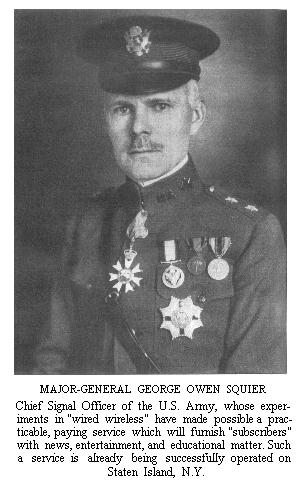 SUPPOSE you had a compact little single-control receiving instrument which you plugged into any one of your electric light sockets and received, at specified times, the latest world and local news, music of all kinds, play-by-play (or blow-by-blow) reports of the big sporting events, extension courses in whatever might interest you, information regarding where to shop for everything from footwear to furniture authoritative talks on the theatre books health, cooking, etiquette, and what-not--all with a minimum of interference, three hundred and sixty-five days in the year.
SUPPOSE you had a compact little single-control receiving instrument which you plugged into any one of your electric light sockets and received, at specified times, the latest world and local news, music of all kinds, play-by-play (or blow-by-blow) reports of the big sporting events, extension courses in whatever might interest you, information regarding where to shop for everything from footwear to furniture authoritative talks on the theatre books health, cooking, etiquette, and what-not--all with a minimum of interference, three hundred and sixty-five days in the year.
And suppose you could get all this at about half the cost and none of the bother or uncertainty of the common broadcast receiver.
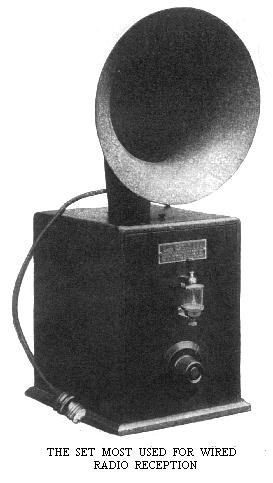
You can--if you happen to live on Staten Island!
But if you don't, never mind; because the first commercially practicable "wired radio" broadcasting service, which has just been put into operation by the Wired Radio Service Company, gives promise of such universal popularity that similar services will no doubt spring up throughout the land almost before you have time to read up about it.
Of course the old-fashioned kind of broadcasting (about two years old now, isn't it?) will not immediately curl up its aerials and die, leaving a vast and sentimental radio audience weeping over the expensive carcass. No, the two services will continue side by side. You can probably think of various reasons why this will be so. Here are a few:
1. Fans will always want to tune-in "distance," both because it's distance and because arriving at success as a result of their own skill will never fail to give a very real pleasure.
2. The appeal of wired wireless is not primarily to the amateurs and fans--it is to that far greater part of the population which either does not own receiving sets or is temperamentally disinclined to fuss with them.
3. "Space" broadcasting will always be the more economical system in sparsely settled regions. The wired wireless service is essentially for towns and cities, where the expense per subscriber is low.
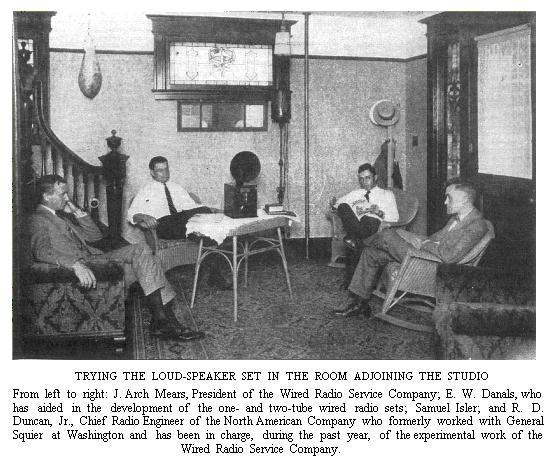
In brief, this is the way the Staten Island service came into being: The North American Company, a public utility holding company operating electric lighting and power companies in Cleveland, St. Louis, and many other places, obtained a sixty-day option from General Squier on a license to use his invention commercially. Experiments in Cleveland during this sixty-day period gave the officials of the company confidence in the tremendous possibilities of wired wireless if properly applied for public service. The license was obtained forthwith, and further experiments over the circuits of the Potomac Electric Company in Washington were eminently successful.
The rehearsals having been given, so to speak, the show was presented to the public--on Staten Island. Mr. C. W. Hough, President of Wired Radio, Incorporated, which is controlled by the North American Company, is in general charge of all this wired radio work; and the Wired Radio Service Company, mentioned above, is a subsidiary of Wired Radio, Inc., formed to carry on operations throughout New Jersey and in parts of New York and Connecticut. It is this latter organization which has just started supplying a daily broadcasting service to Staten Island homes over the ordinary, unchanged house lighting wires.
Mr. J. Arch Mears, President of the Wired Radio Service Company, says:
There are about 25,000 potential subscribers to the service which we have established on Staten Island; but they are only a fraction of the number which our company expects to be supplying before long. When you consider that there are in the country 12,000,000 houses wired for electrical power, of which the organizations associated with the North American Company supply approximately 1,500,000 with electric service, you can see that if even a comparatively low percentage of these subscribed to the broadcasting service, the revenue from the tremendous business that would result would be sufficient to enable us to procure the very best talent, the most important and interesting programs. There are between 3,000,000 and 4,000,000 potential subscribers (families or organizations) within 200 miles of New York City, the greatest program source in the world. The probable--in fact the inevitable--growth of wired radio which we going to see within a few years fairly staggers the imagination.
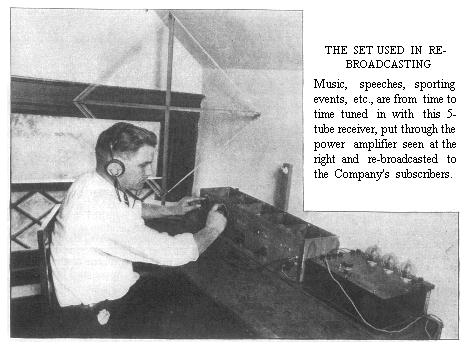
AT IS HAPPENING OVER ON STATEN ISLAND
BUT let us cross over to the broadcasting plant on Staten Island and see what is going on there. It is a half-hour ferry trip from the Battery to St. George, then a couple of miles' train ride to West Brighton, where the studio is located. The broadcasting is done from a three-story stucco house leased by the company. On the first floor are the reception room and studio, the latter, like the ordinary radio studio, being hung with heavy monk's cloth to absorb all sounds except those entering the microphone.
On the second floor is the transmitter room, containing the apparatus which delivers the radio-frequency impulses directly to the 2,300-volt power lines. There are two transmitters: the small one shown at the left in the photo on page 470 is a spare set for use in case the large set should be out of commission. The oil switch for the 2,300-volt lines is seen mounted above the control panel in the centre.
THE WIRED RADIO NEWSPAPER
IN AN adjoining room is the automatic apparatus which receives news directly from the United Press Association's offices in the World Building, New York City; for not the least important part of the wired radio service is the news summaries delivered to the subscribers' loud speakers or phones at the same time that they are sent to some seven hundred newspapers all over the country. Mr. James T. Kolbert, of the United Press Association, is Editor of this newly established wired radio newspaper.
This phase of the service is not provided as a substitute, as one might at first imagine, for the ordinary daily paper of wood pulp and printer's ink. It is true that it supplies news of local and world-wide importance, but it is rather as an arouser of interest that its sponsors expect it to prove of greatest value. What is important or interesting for people to read about is told briefly.

Before long an advertising wavelength will be operated, at some morning hour suited to the convenience of the women, who are the chief buyers. They will be told, by women, just where and when to shop for their special requirements. It will be readily seen that the printed newspaper will always have the advantage that, although it may arrive several hours later than the radio bulletins, it can be picked up at the reader's pleasure, read as leisurely and as often as may be desired and contains much more completely the facts and discussions that are broadcasted over the lighting wires. It is expected, however, that the radio newspaper service will broaden people's interests in a way that a daily paper alone cannot do. Those whose interests have revolved chiefly about their own local worlds will find themselves following, from day to day, in the press and in the conversations of their associates, what the world at large is doing and thinking. This, if brought about on a large scale by intelligent and discriminating wired broadcasting, will be a tremendous thing. The instrument is a powerful one, and the responsibility that goes with the privilege of using it, is great.
DISTANCE MADE POSSIBLE ON A CRYSTAL SET
UP ON the third floor of the broadcasting house is a five-tube loop receiver, whose output may be switched directly on to the electric lighting lines and received by the subscriber. It need scarcely be pointed out that the chief significance of this phase of the Wired Radio Service Company's activities is that it makes distant programs available for crystal receivers.
Thus, we find three distinct sources of broadcasts--performers in the studio, news from the United Press Association, and space radio re-broadcasted--all -sent over the same lines and audible to every subscriber by and rented from the company--is plugged into one of his light sockets.
THE RECEIVING SETS SUPPLIED TO SUBSCRIBERS
VARIOUS types of sets have been designed are and provided by Wired Radio, Inc. which are leased to subscribers at prices ranging approximately from two to five dollars a month. (This charge, by the way, is tacked on the subscriber's lighting bill.) All the sets have crystal detectors. The simplest one has a semi-permanent crystal and a single tuning control. The crystal is of a type which is less sensitive to weak signals than the ordinary mineral, but equally good on strong signals; and since all signals received over the lighting lines are as strong as necessary, this type of crystal is just the thing! The beauty of it is that after you have adjusted it by turning a thumb-screw slightly, it stays set for an indefinite period, in spite of jarring the table, moving the set from place to place, and other actions fatal to the adjustment of the ordinary crystal. These sets are designed for use with headphones.

Most people prefer to listen to their radio entertainment from a loud speaker instead of having to wear headphones, which are often heavy, and, in summer especially, decidedly hot. For such subscribers, a compact little outfit has been developed which reproduces signals received over the lighting lines with volume sufficient to fill the ordinary-size living-room. It contains only two tubes--WD-12's--but one of them is reflexed, so that the effect is obtained of one radio-frequency stage, detector (crystal), and two audio-frequency stages. This set is shown below and on page 465.
Still another receiving set, which has not yet been put in service, has been designed for use in stores, theatres, and other places where a particularly loud signal is needed. As in the case of the other models, the filament current will be supplied from the lighting wires, and the tuning will be simple enough for any one to master without much practice or instruction. Radio is thus handed to the non-technical, non-experimenting "general public" on a silver platter. There is not much to go wrong, and if anything does, a man from the company will come around and remedy the trouble, like the telephone service man. In other words, when a subscriber pays so-much-a-month for a receiving set, he is paying at the same time for whatever service may be necessary to keep it in good order.
There is no reason why one house should not operate several sets at the same time if desired. No interference or diminution of signal results. And there is no reason why a triple socket, for instance, should not have plugged into it a toaster, a flat-iron, and a receiving set. As in the case of any other electrical appliance, the radio set, when once connected to the socket, is put in use simply by turning on the electric light switch.
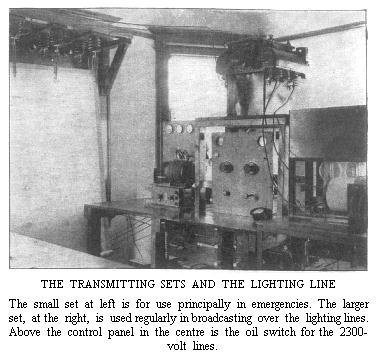
At present, all programs are transmitted on the same wavelength--about 8,000 meters--but the company expects soon to operate a dance wavelength, an advertising wavelength, and an educational wavelength simultaneously. Practically anything the subscribers indicate that they want in the way of programs can be supplied. If enough of them, for example, want a half-hour talk on books and literature each evening, they will given it on a special wave-length. They will be able to turn their single tuning control to dance music, which will be on tape practically every evening, or to opera, or lectures. This, it will be seen, approaches rather closely the "fantastic" imaginings of writers and artists a few years ago who pictured a small box from which all sorts of entertainments could be drawn at will, like to eat at the Automat.
How quickly and how widely the public is going to take up wired radio cannot yet be foretold with accuracy. Nor can it be said how cheaply an A1 service can be offered to large communities. The cheapness and the quality, of course, depend principally upon the number of subscribers obtained in any given district. In New York and the vicinity, for instance, the best conditions may well be expected.
Programs originating in a wired radio broadcasting studio in New York could be sent as far as Chicago if it were necessary to do so. But the difference in time in Chicago (which would make bedtime stories from the Metropolitan area, for example an hour too early for the Windy City's younger generation), as well as the fact that people will generally prefer programs of more local interest, make it unlikely that wired radio will ever be used over distances of many hundreds of miles. Space broadcasting will take care of the long-distance work sufficiently well.
Wired radio, then, is not going to "revolutionize" broadcasting, since it differs greatly from "space" radio as regards the people it appeals to and the service it offers. If it revolutionizes anything, it will be the point of view of thousands of people whose interest will be stimulated in things worth while, through a service within the reach of practically everyone.
 SUPPOSE you had a compact little single-control receiving instrument which you plugged into any one of your electric light sockets and received, at specified times, the latest world and local news, music of all kinds, play-by-play (or blow-by-blow) reports of the big sporting events, extension courses in whatever might interest you, information regarding where to shop for everything from footwear to furniture authoritative talks on the theatre books health, cooking, etiquette, and what-not--all with a minimum of interference, three hundred and sixty-five days in the year.
SUPPOSE you had a compact little single-control receiving instrument which you plugged into any one of your electric light sockets and received, at specified times, the latest world and local news, music of all kinds, play-by-play (or blow-by-blow) reports of the big sporting events, extension courses in whatever might interest you, information regarding where to shop for everything from footwear to furniture authoritative talks on the theatre books health, cooking, etiquette, and what-not--all with a minimum of interference, three hundred and sixty-five days in the year.





